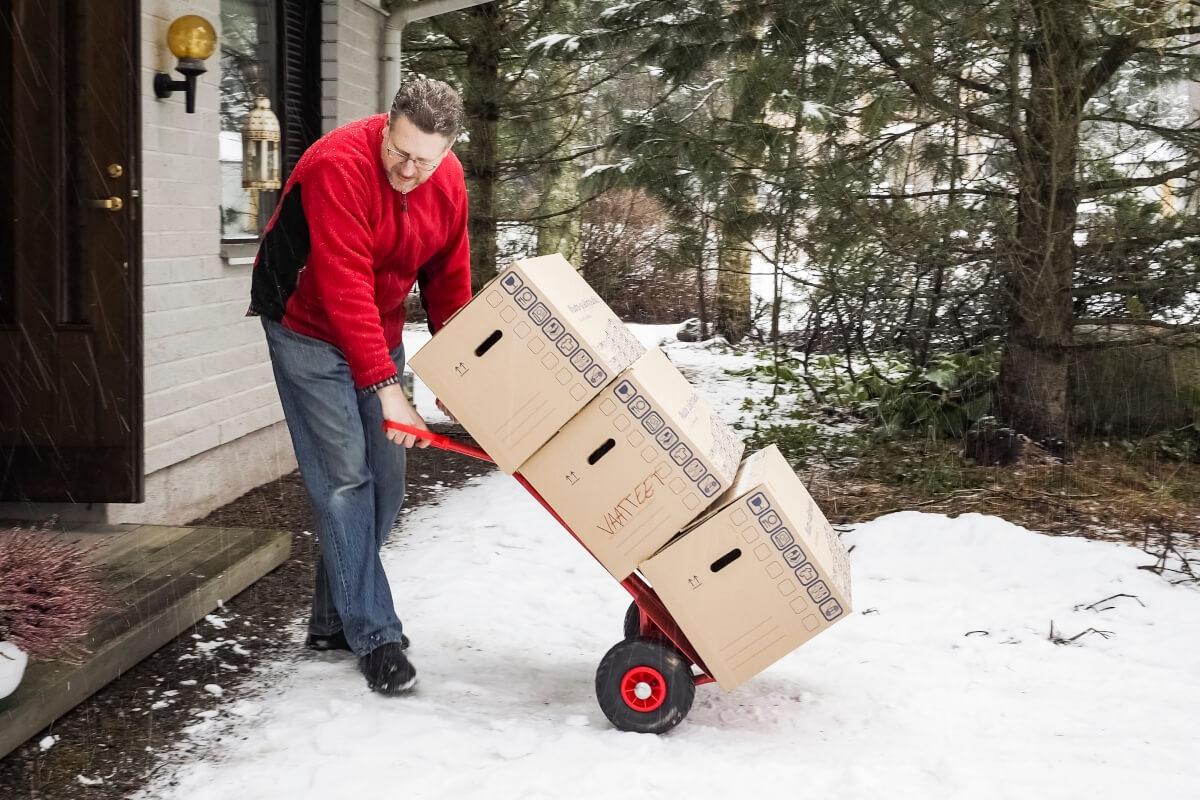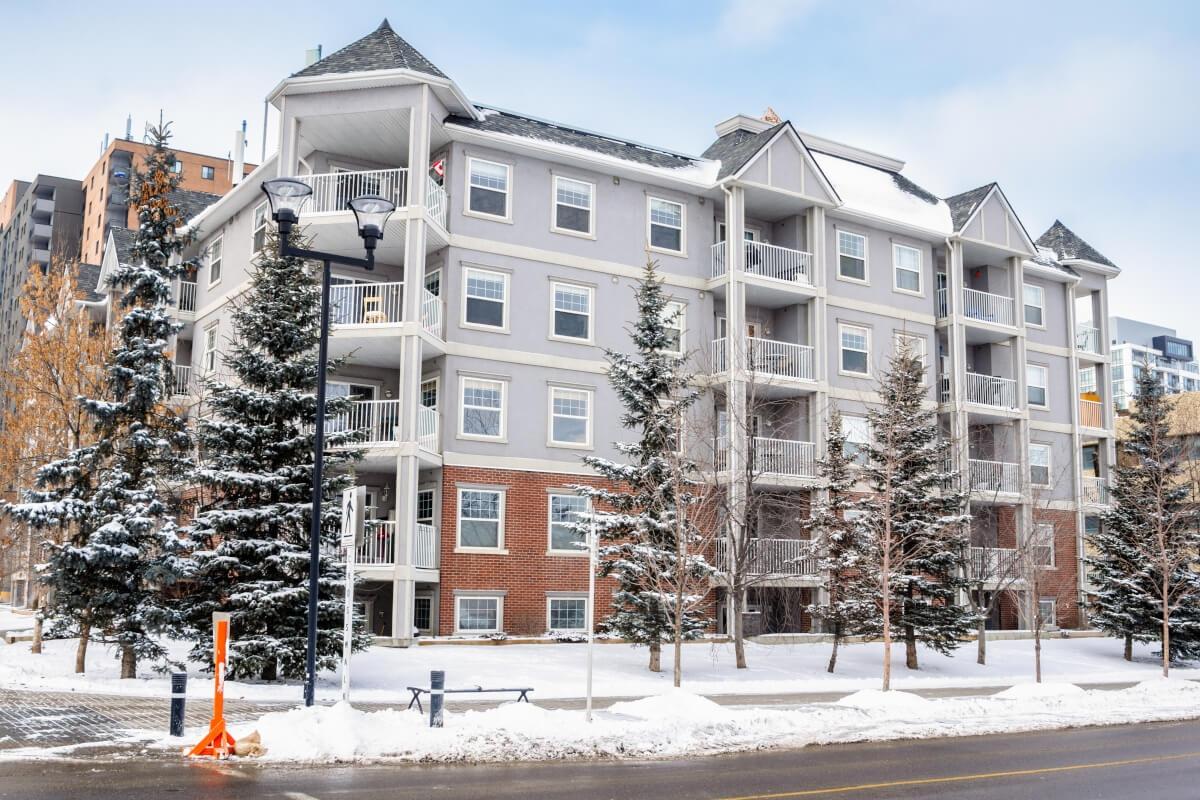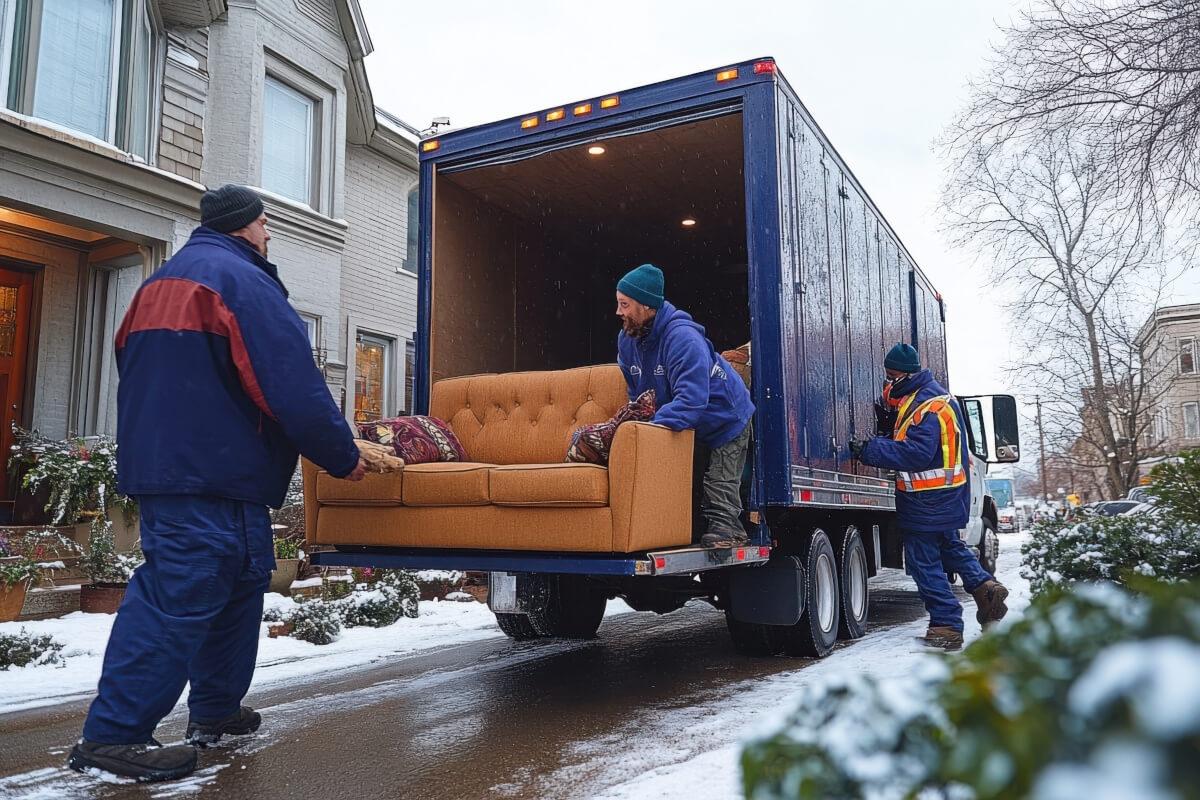When you think of winter, apartment hunting and moving might not be the first things to come to mind. However, despite popular belief, winter can be an opportune time to move into a new apartment, settle down, and start a new chapter alongside a new calendar year.
If you’re not entirely sold on the idea of a winter move, we understand the hesitation. Moving in the winter can mean hauling boxes in harsh weather or rearranging your work schedule to coordinate with movers. However, these obstacles aside, moving in the winter can have some invaluable advantages that might change your mind.
In this article, we’ll discuss the benefits of moving in the winter, along with practical tips and tricks for making the process as smooth and stress-free as possible. Here’s a look at some of the topics we’ll cover:
- Pros of moving in the winter
- Cons of moving in the winter
- Tips for apartment hunting in cold weather
- Step-by-step winter moving timeline

Benefits of Moving in the Winter
When it’s cold outside, you’d probably rather be cozied up by your fireplace than out apartment hunting. This is the thought process for most renters, which is exactly what makes moving in the winter so advantageous. By making your move during the rental “off-season,” you can reap some of the following benefits:
Lower prices
Winter is the season of savings for renters. Because this season tends to see lower demand among renters, apartment communities and moving companies will often incentivize people with competitive pricing. This can include discounted rent, waived application fees, or even perks like free parking or amenity access.
While apartments might still offer deals later in the year, they likely won’t compare to winter pricing. Because it’s deemed the “off-season,” winter will be your best chance at securing a low monthly rent rate and other financial perks.
Less competition
Less market demand means it’ll be easier for you to score your dream apartment. Whether you’re seeking an open floor plan, luxury amenities, or a specific location, your chances of finding an apartment that checks all your boxes are higher in the winter.
Like canned goods during a snowstorm, sought-after apartments will fly off the shelves during peak renting season. By avoiding the frenzy of summer and spring moves, you’ll have your pick of the crop and more negotiating power to secure your apartment of choice.
More flexibility
Another benefit of moving in the winter is flexibility. During the busy season, apartment communities and moving companies have less availability. Whether you’re trying to schedule an apartment tour or book a moving truck, you might find it difficult to secure a convenient time slot if you move in the summer or spring.
In contrast, the winter moving season yields much more flexibility and options. Most moving companies and apartments will have ample openings, allowing you to book tours or moving services on dates that work best for you. This flexibility, along with the other above-mentioned benefits, is what really incentivizes renters to schedule a winter move.

Drawbacks of Moving in the Winter
While winter moves offer savings, flexibility, and less competition, they also have several drawbacks. If you live in an extremely cold climate, have school-aged children, or are in a rush to move into your new place, you might rethink your winter moving plans for the following reasons:
Longer moving process
One of the biggest downsides of moving in the winter is that it can take some time. Because it gets dark earlier during this time of year, you may have to break up your move into multiple days. On top of that, there’s a chance that bad weather could delay the moving process as well. If you’re dealing with snow or ice, driving on roads and moving furniture safely and efficiently may be difficult.
Poor weather conditions
Depending on where you live, your winter move might be affected by poor weather conditions. If you live in an area with potentially hazardous conditions, such as snow or ice, you’ll have to plan around the weather. This means being prepared for potential delays and taking extra precautions to weatherproof your packing.
Potential scheduling conflicts
The other issue with a winter move is that it could lead to scheduling conflicts. If you’re moving during the holiday season, you may need to adjust your timeline to accommodate family gatherings. Or, if you’re moving in January or February, you may have to move things around to accommodate your work schedule.
Scheduling conflicts can also arise if you have children. Moving in the winter means moving during the school year, which could impact your kids' attendance or disrupt their routine. If possible, plan so your child doesn’t miss any school. If you’re moving to another state or school district, you may also need to time your move so your child can enroll in a new school and easily transition.

Tips for Apartment Hunting in Cold Weather
If you’re sold on the idea of a winter move, now is the time to start your search! However, to reap the full benefits of this season of savings, you’ll have to be prepared to brave the cold. So, bundle up and start browsing with these winter apartment-hunting tips:
Start online
To spare yourself some time in the cold, begin your apartment hunt by browsing online listings. Start by searching on a reputable rental platform like Apartments.com, where you can discover thousands of apartment listings in your desired location, budget, and preference. You can then narrow down your search to a few contenders and schedule tours accordingly.
Schedule multiple showings for one day
When scheduling showings, it may be wise to stack your tours. This will minimize the number of days you have to venture out into the cold. Not to mention, it may also make it easier for you to compare options when they’re all fresh in your mind. Just be sure you leave enough time between showings so you’re not rushing.
Dress appropriately
If you’re apartment hunting in extreme temperatures, make sure to dress appropriately. Touring apartment communities means you’ll likely explore some outdoor amenities like pools, grilling areas, and dog parks. So, it’s important to bundle up and brace yourself for some outdoor ventures with adequate layers, a warm coat, and comfortable shoes to walk in.
Prepare for your move
Though winter moves offer more flexibility than summer ones, they still require a lot of preparation. Take advantage of seasonal deals by shopping for movers or rental trucks early. Booking these services a few weeks in advance will help you avoid last-minute hassles. You should also be proactive about the weather. Though forecasts can change, still keep an eye on local conditions and plan accordingly.
If bad weather is coming your way, you can prepare by stocking up on the right supplies. Gather essentials like salt, shovels, moving blankets, and plastic tarps for handling snow and preserving furniture. To prevent water damage, consider using plastic bins instead of cardboard boxes to store your belongings. Wrap delicate furniture with plastic and moving blankets to guard against freezing temperatures. And don’t forget personal safety—wear layered clothing, non-slip boots, and gloves, and keep a first-aid kit nearby with thermal blankets and a flashlight. Careful planning and preparation will help you and your items arrive safely.
Make arrangements for kids and pets
Moving in the winter can be challenging enough. Add the task of managing kids or pets, and it can be even more difficult. To ensure your furry friends or young children stay safe during the move, it’s important to plan ahead. If you're moving locally, consider boarding your pet in a temperature-controlled facility or leaving them with a trusted family member or friend. For long-distance moves, prepare a travel kit with food, water, medicine, and comfort items, and plan for breaks to let your pet stretch and go potty. The same applies to young children—pack snacks, toys, and comfort items to keep them occupied during the trip.
Once you arrive, set up a safe, quiet space for your pet in your new home or board them temporarily at a nearby facility. If keeping them in a room, provide water, their crate or cage, blankets, and toys to keep them comfortable. For older children, assign small tasks to help them feel involved, but if they’re too young, arrange for someone to supervise them. Moving can be stressful for pets and kids, so having a plan will make the process smoother for everyone.

Your Winter Moving Timeline
1. Start packing
Two weeks before the big day, make sure your packing is going according to plan. Everything should be packed and squared away before moving day to expedite the loading and unloading process. Remember, it gets dark early during the winter. Don’t waste daylight hours packing when you should be further along in the moving process.
2. Transfer your utilities
About a week or so out, double-check that your utilities are transferred and ready to be switched on at the new place. Even one night without heat is dangerous in freezing weather. You’ll want to confirm that at least your water, power, electricity, and gas will be on by moving day.
3. Gather packing supplies
Double-check that you have everything crossed off your safety and packing supply list. You won’t have time to stop at the store while you’re moving. Save yourself the aggravation and get everything you need well in advance.
4. Confirm details
Make sure everyone helping you during the moving process is on the same page about what they need to do and when they need to do it. Call your movers to confirm your moving day plan. Check in with any pet sitter, boarding facility, and babysitter to ensure your arrangements are still on schedule.
5. Set aside delicate items
Set aside items that won’t be packed away in the truck. These can include personal belongings like electronics, important documents, and valuables. Make sure to keep these items with you during the move so they don’t get lost or damaged. If you’re storing electronics, make sure to secure them in a dry, temperature-controlled container.
6. Make a weather call
The safety of you and your movers should always come first. If severe weather is forecasted, consider postponing your move. Stay updated on the weather conditions, as they can change unexpectedly, for better or worse.
7. Make last-minute preparations
Check that all items are properly packed and wrapped to prevent damage. Go over your supply list to ensure you didn’t forget anything.
8. Plan your outfit
Dressing for your move is important, especially in freezing weather. Ensure your outfit is comfortable and warm enough to withstand the moving process. Set these items aside the night before your move so they don’t accidentally get packed away with your other clothes.
9. Clear walkway
If possible, shovel snow and spread salt a few days before your move, both at your current home and your new rental. However, if you're moving from a distant location and this isn't feasible, focus on clearing the sidewalks, stairs, and driveway as soon as you arrive. This ensures a safer and smoother moving process.
10. Protect your new floors
Safeguard your new floors from water damage and reduce the risk of slips by laying down plastic tarps and placing mats at all entrances. If you won’t have access to your space before moving day, ensure these protective measures are in place before the moving process begins.
11. Make a warm room
When you arrive at your new place, consider turning off the heat to prevent overworking your HVAC system. Instead, designate one room as a "warm room" and set up a space heater there. This will provide a cozy retreat for you and your movers to escape the cold. Be sure to place the space heater in a safe spot, away from children, pets, and anything flammable, as they can pose a fire hazard. Always turn off the heater when you reactivate the central heat or leave the house to ensure safety.
12. Get excited
The final step of your winter move is simple: get excited! Moving day can be hectic, but take a moment to relax and embrace the journey. Small touches can make the day more enjoyable, like sipping on a warm cider or hot chocolate during breaks. Reward yourself with your favorite meal once everything is done. Focus on what will make the process smoother and more enjoyable, and before you know it, you'll be out of the cold and fully settled in your new place.
Moving to a new apartment doesn’t have to be stressful—especially if you follow these winter moving tips to stay prepared. A winter move offers the perfect opportunity to start fresh in the new year, so take the time to plan carefully and make the process smooth and hassle-free with help from Apartments.com!
This article was originally published on September 28, 2021, by Oliva Obrien.
FAQs
Is it a good idea to move in the winter?
Moving in the winter can be a good idea if you're looking to save money, as demand for moving services is typically lower. However, you’ll need to prepare for potential weather challenges like snow or ice, which can complicate the process.
Is it cheaper to move in the winter?
Yes, moving in the winter is often cheaper because it's the off-season for renters, leading to lower rates from apartment communities and moving services. You may also have more flexibility with scheduling since fewer people are relocating during this time.
What is the cheapest month to move?
January and February are generally the cheapest months to move, as demand for moving services is at its lowest. Many people avoid relocating during this time, creating opportunities for discounts.
How do you prepare for a winter move?
To prepare for a winter move, check the weather forecast and have a backup plan in case of severe conditions. Make sure to clear snow and ice from walkways and protect your belongings from the cold with blankets or waterproof covers.






